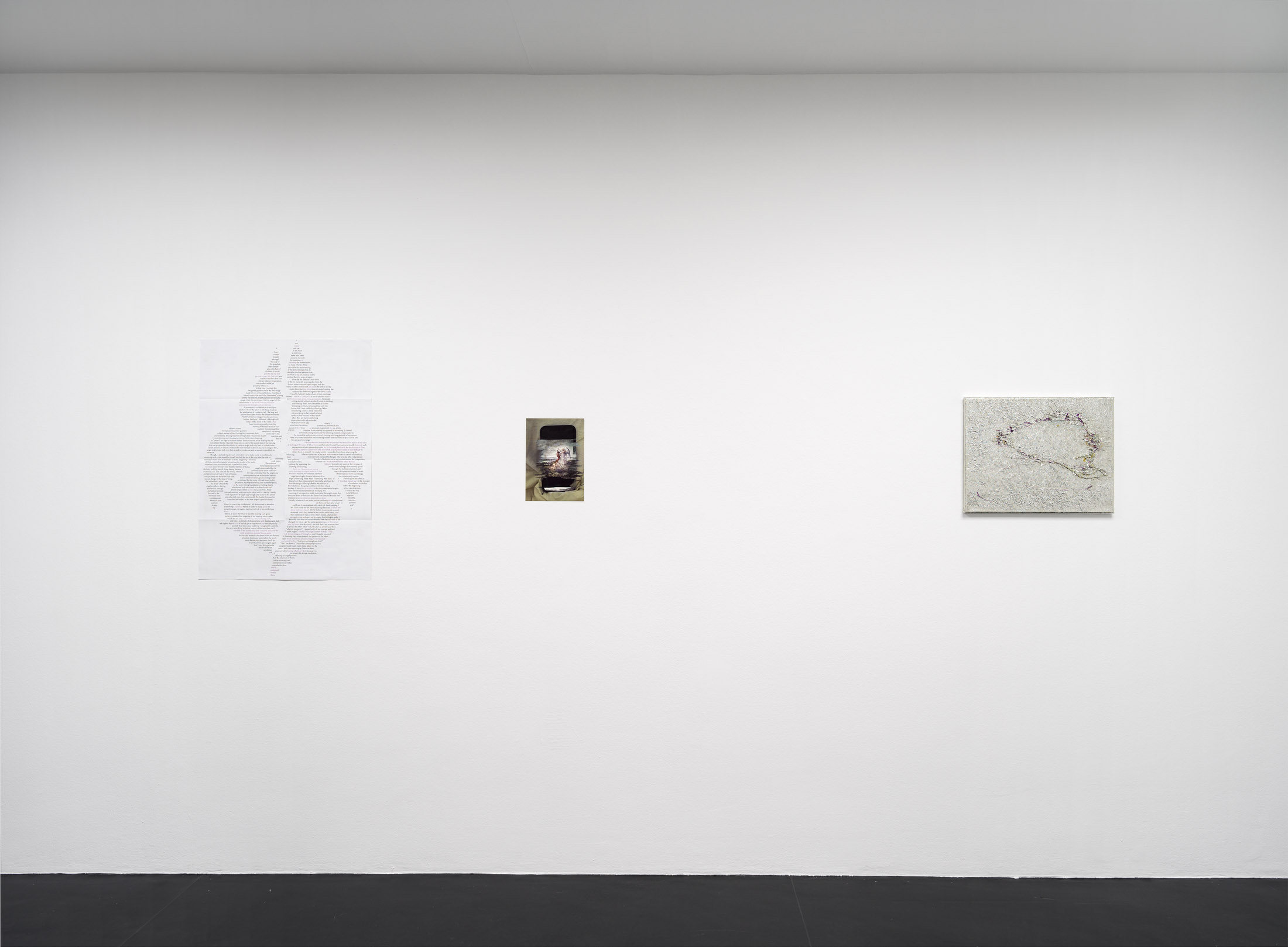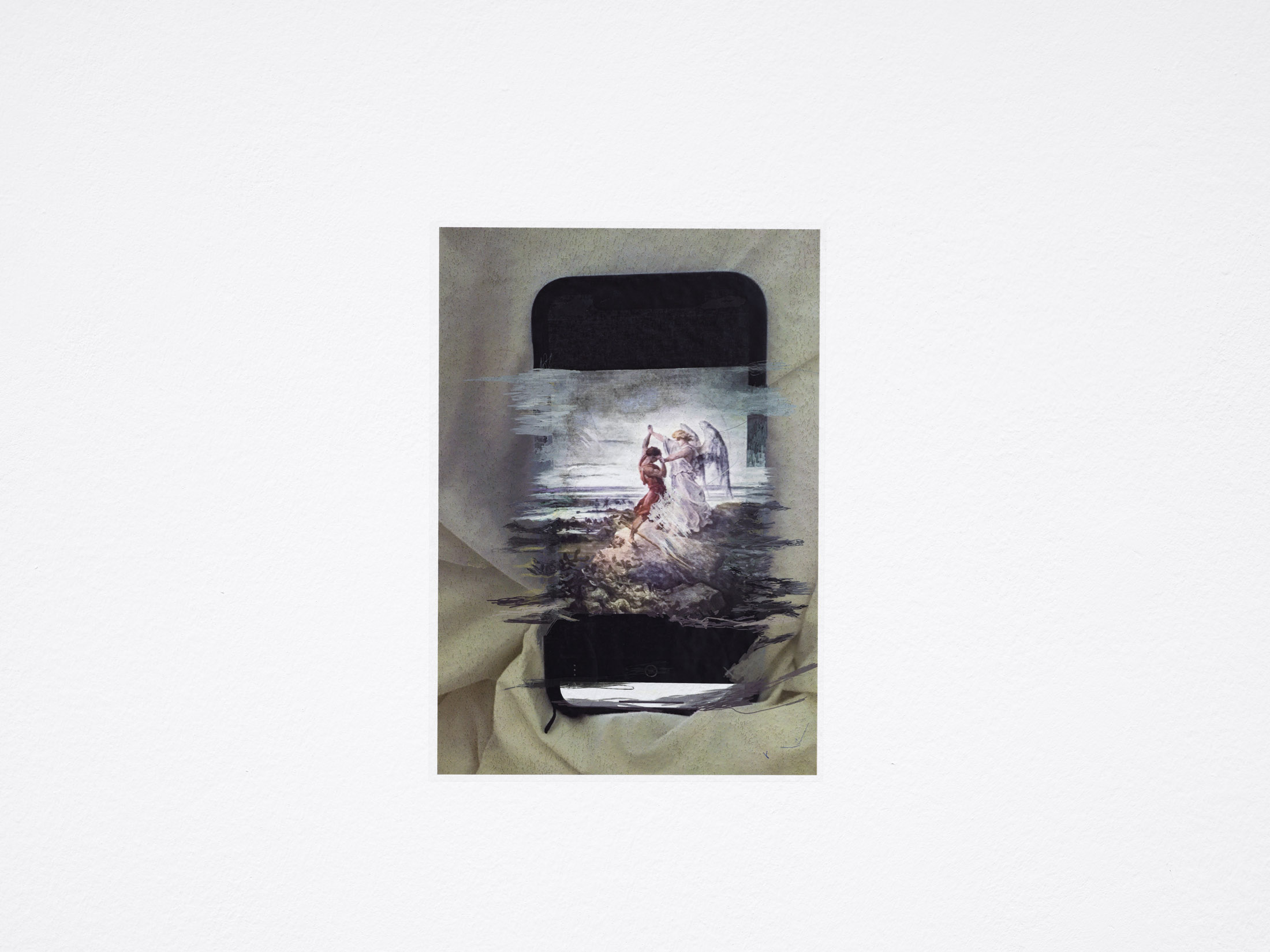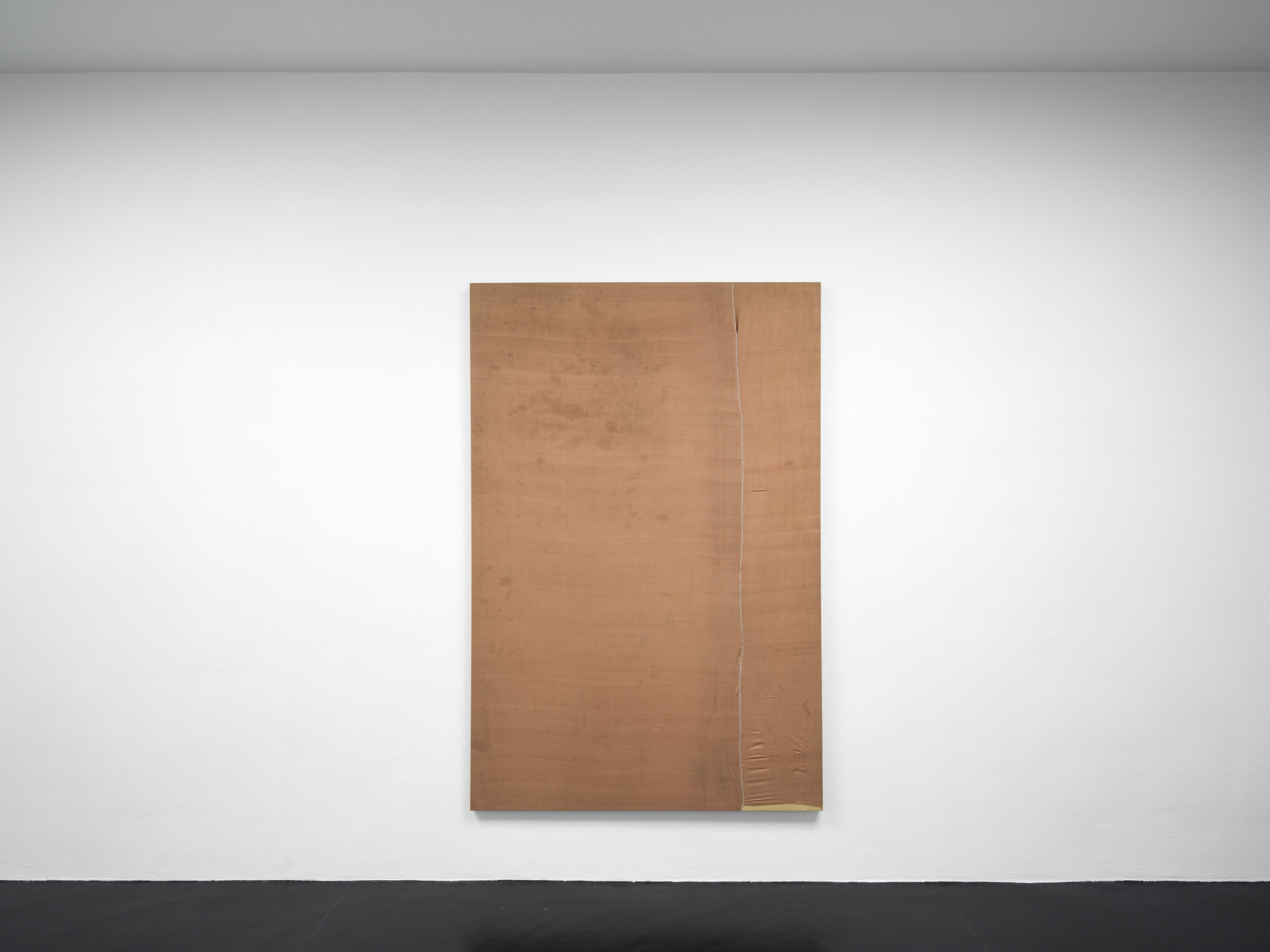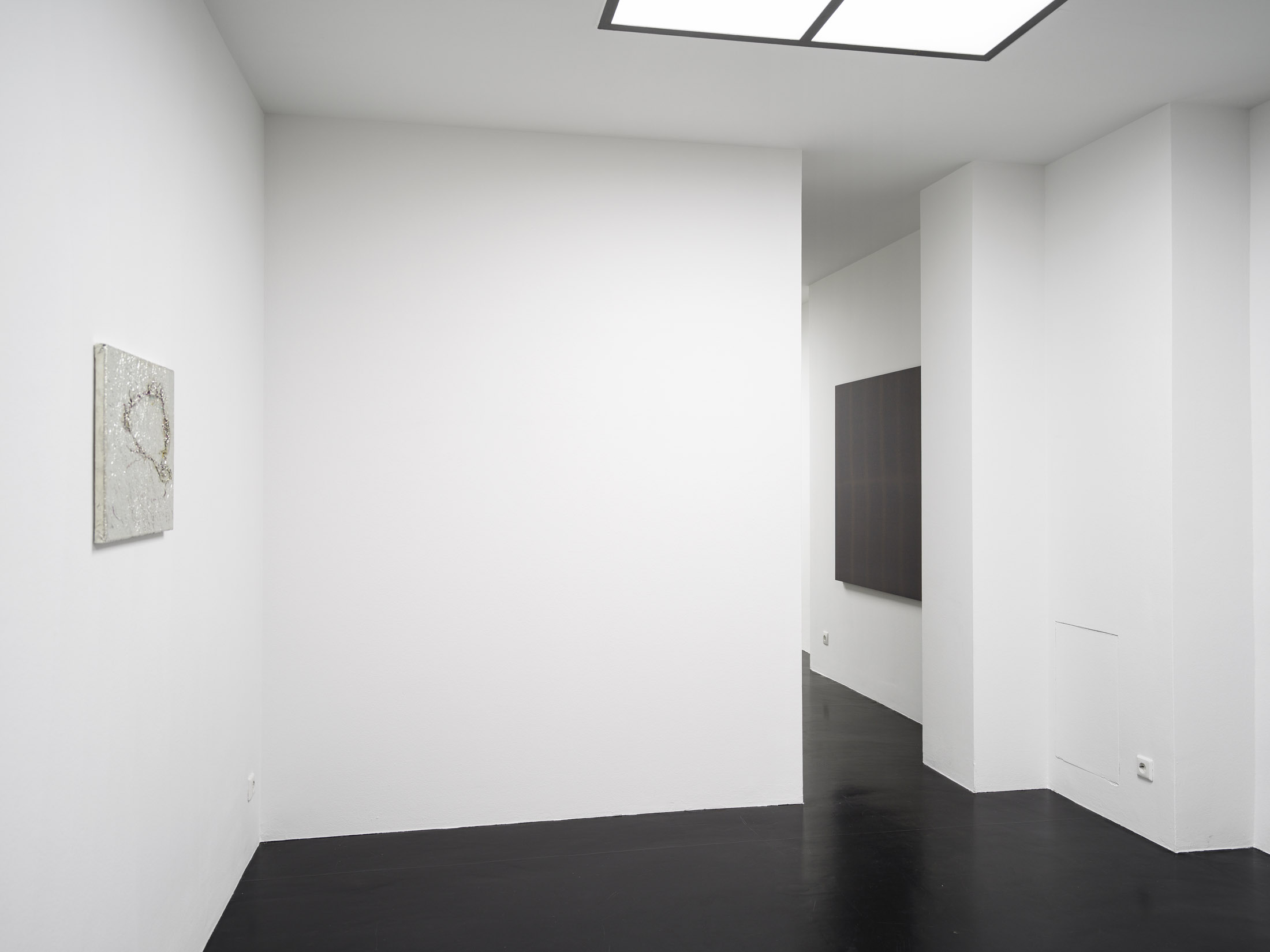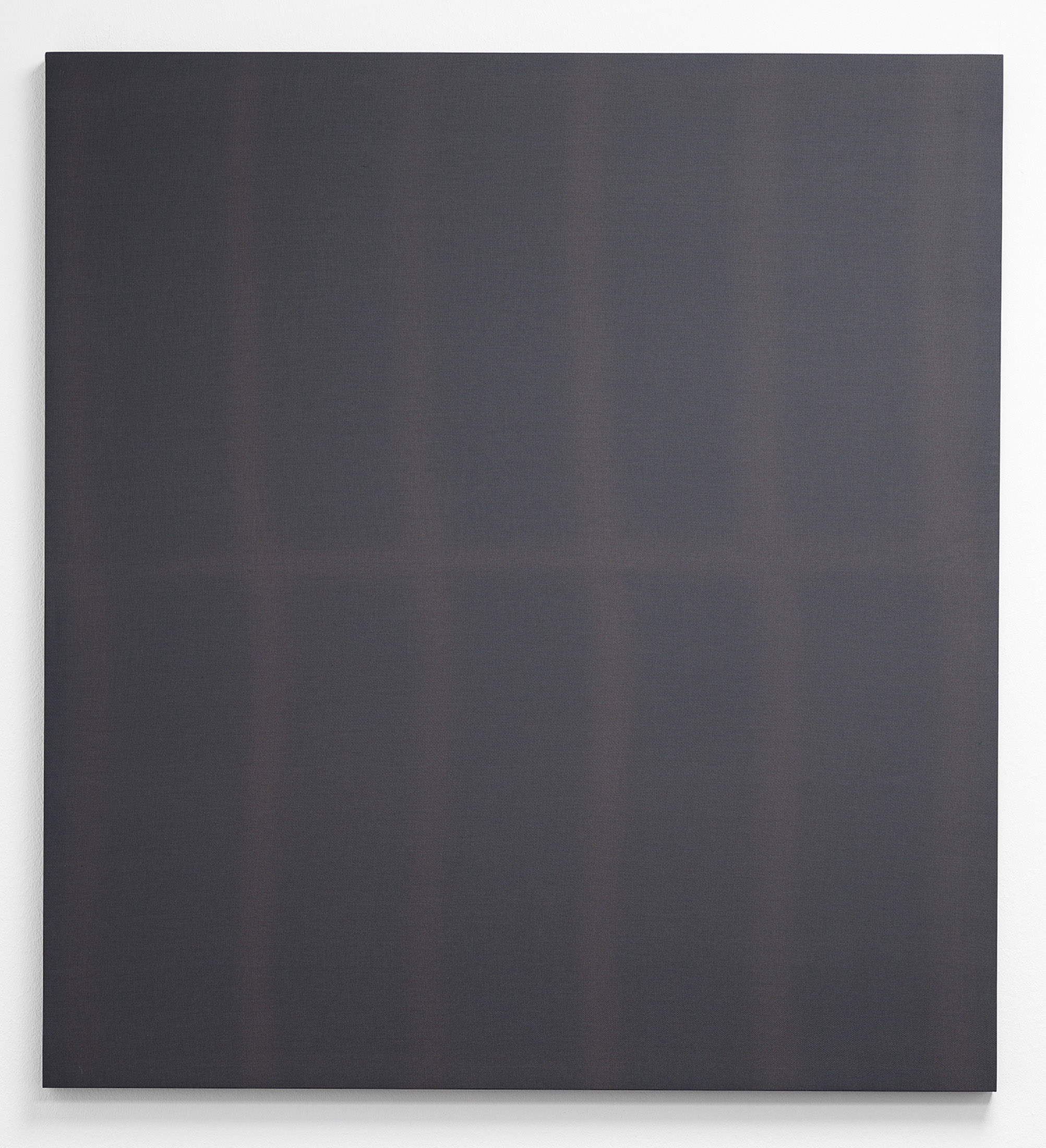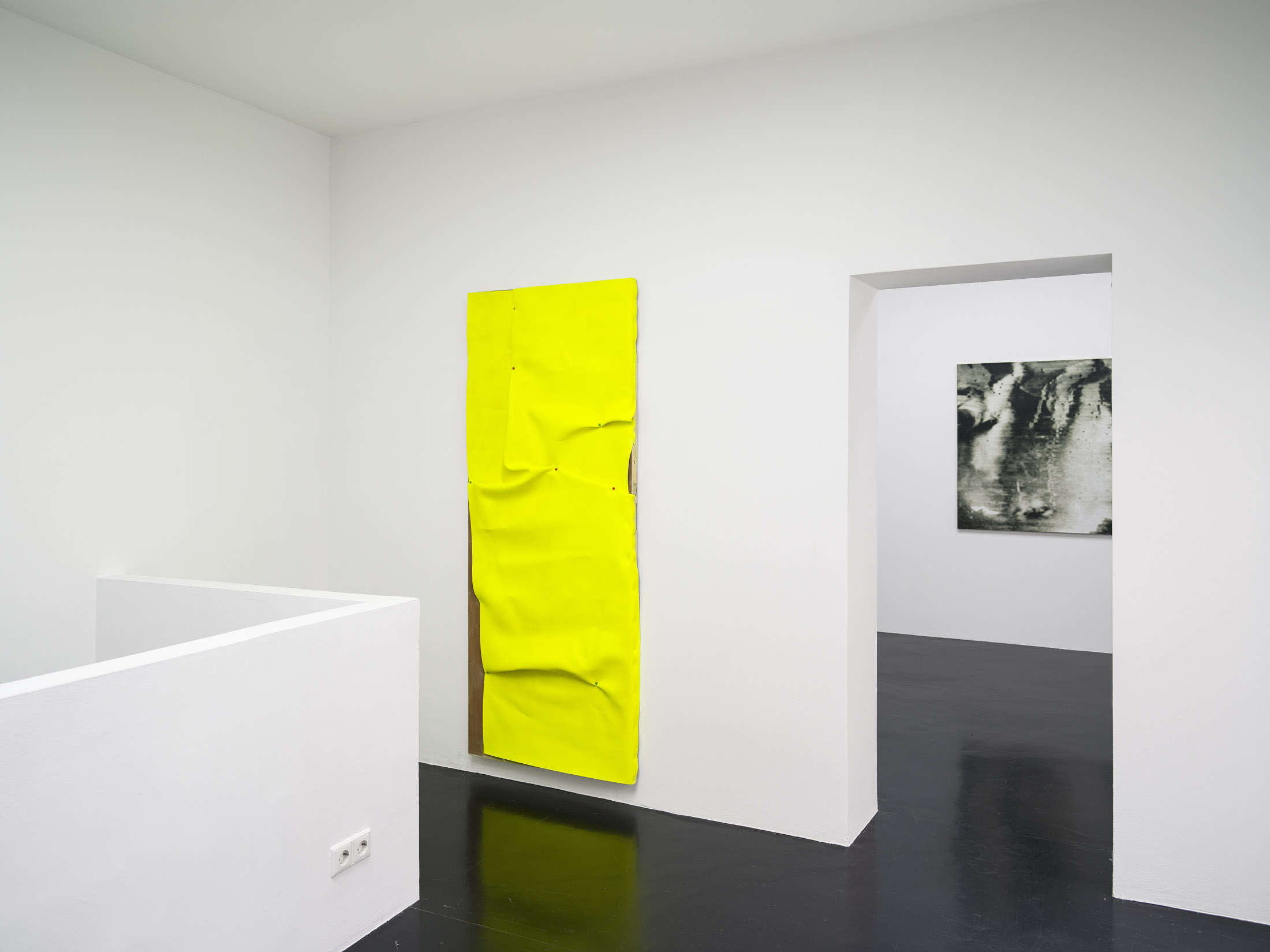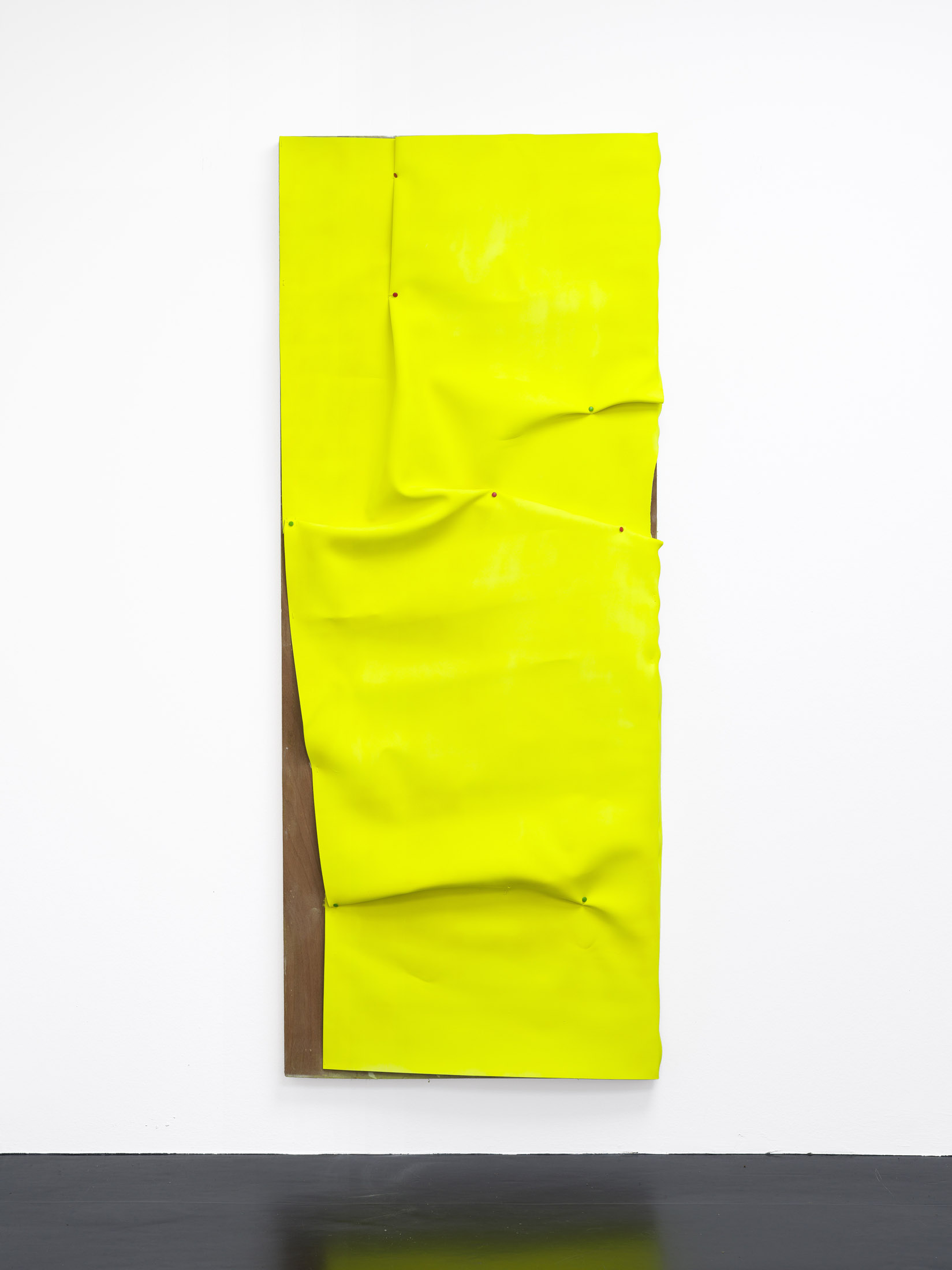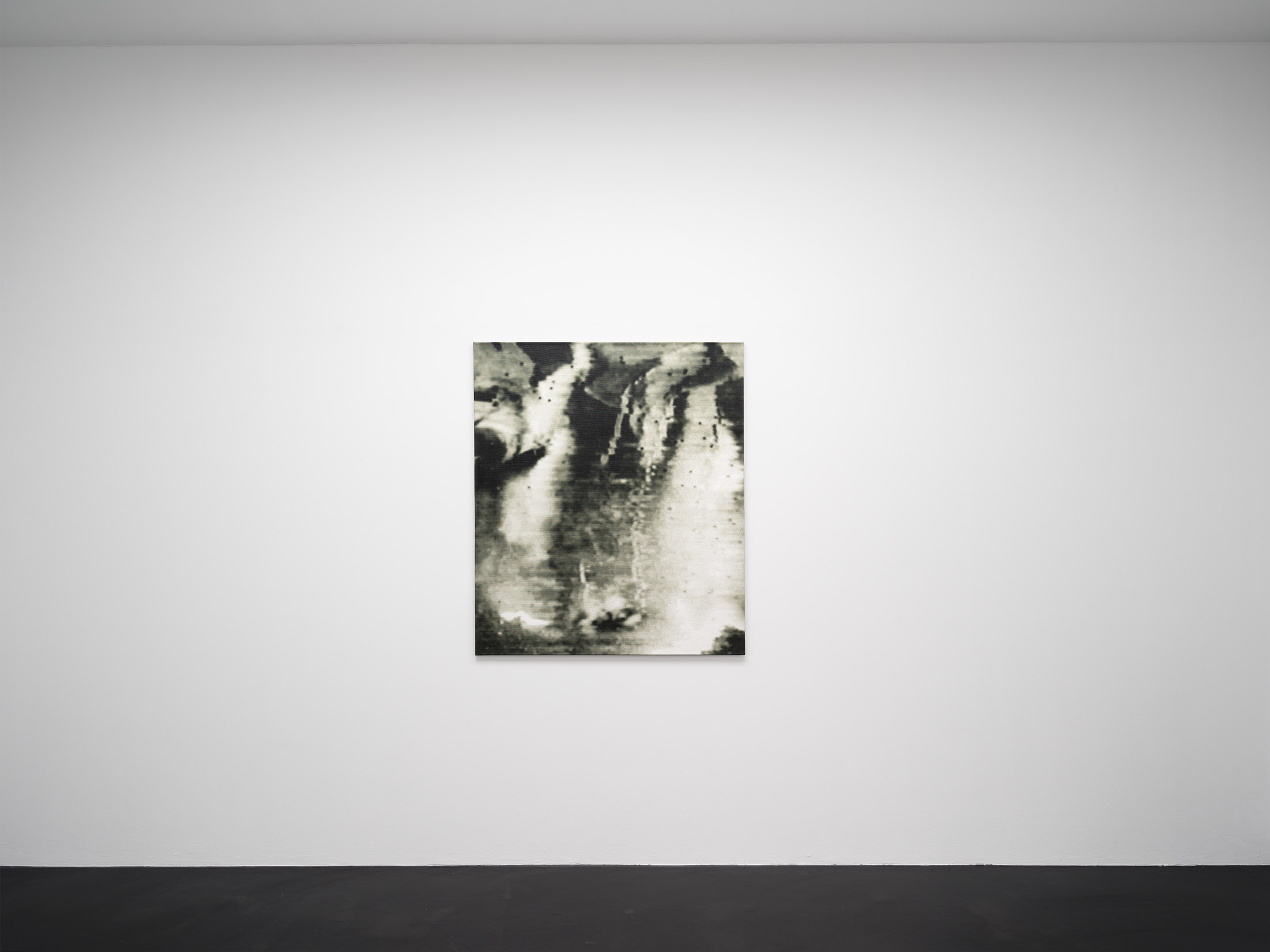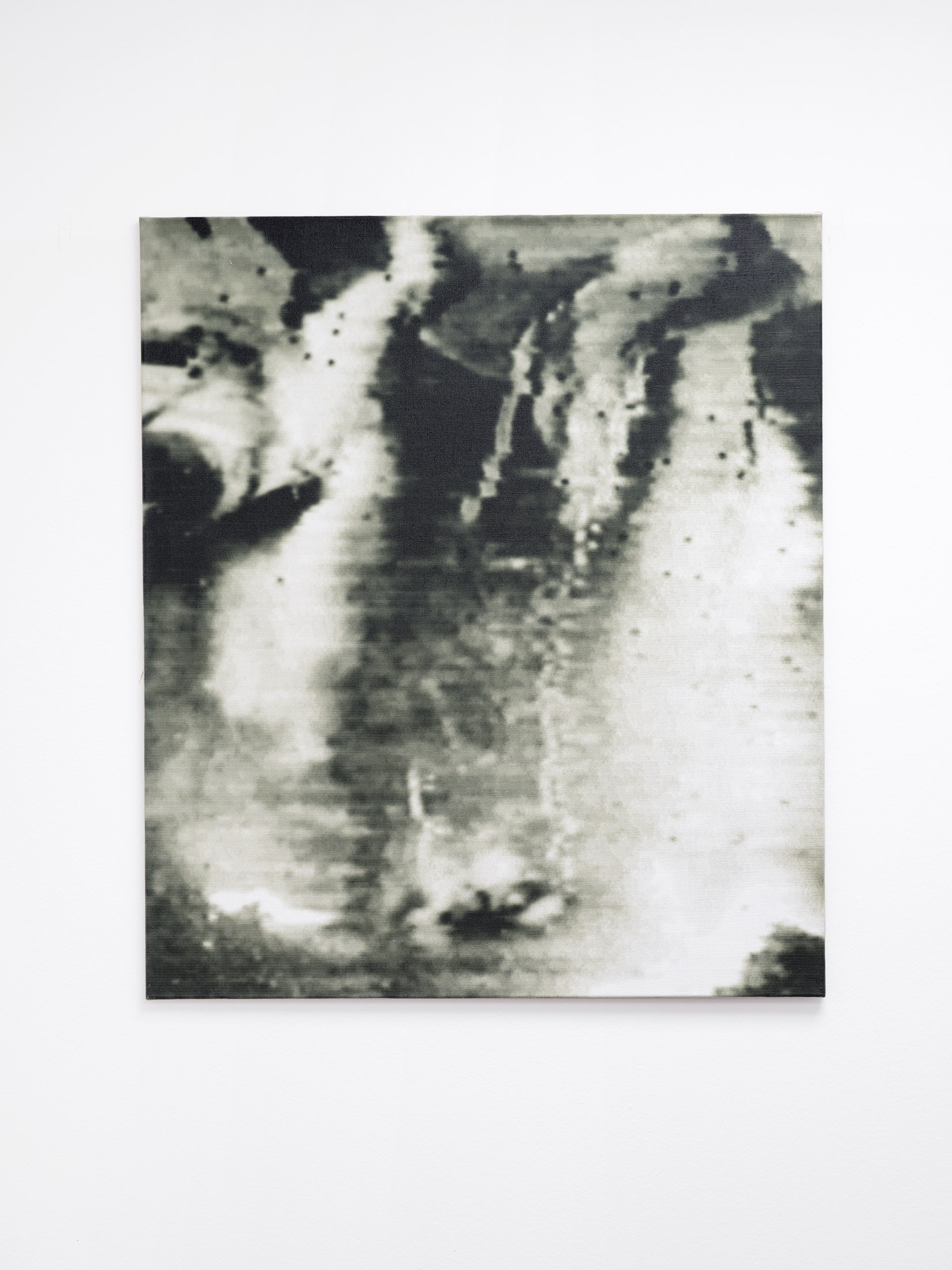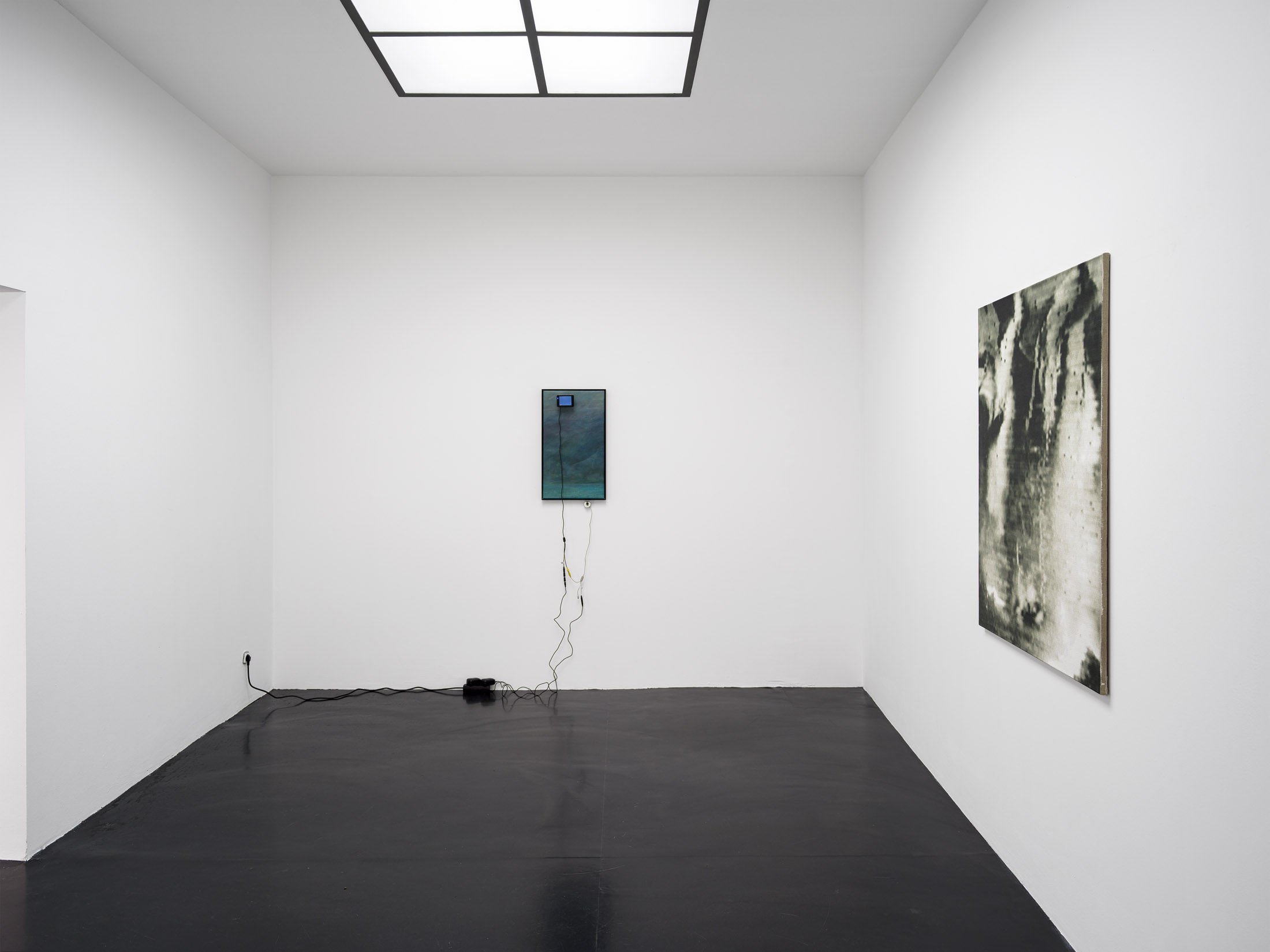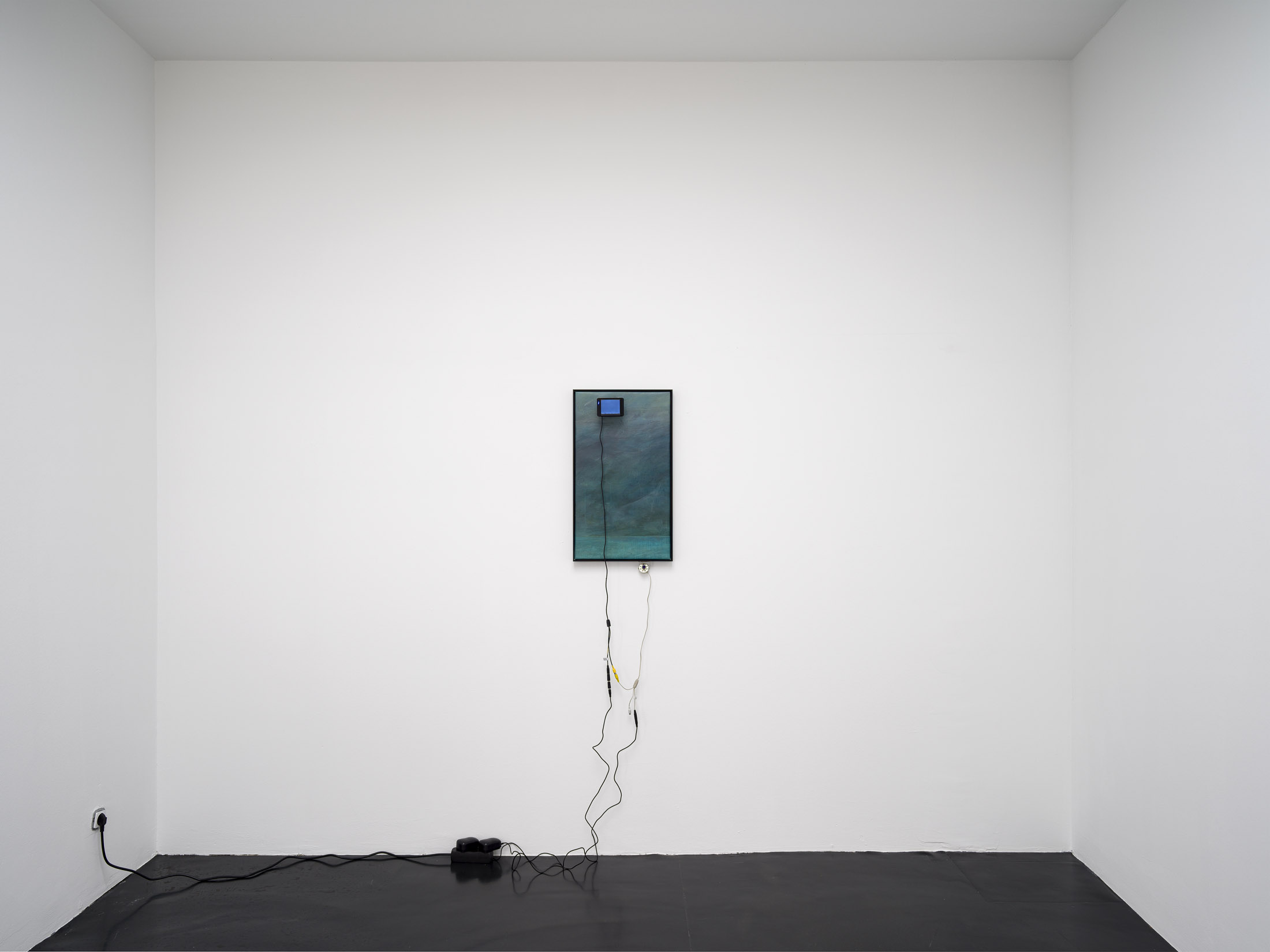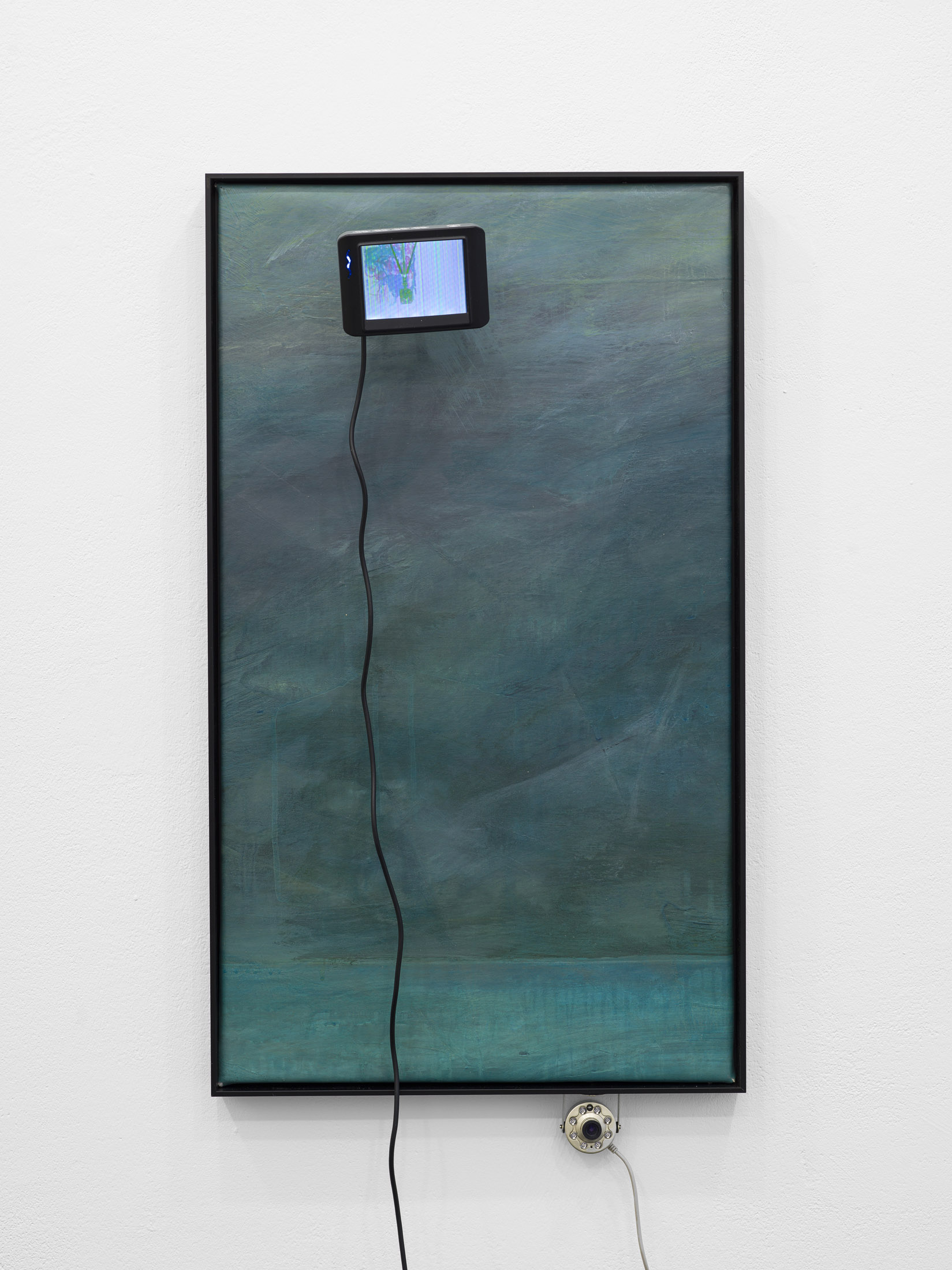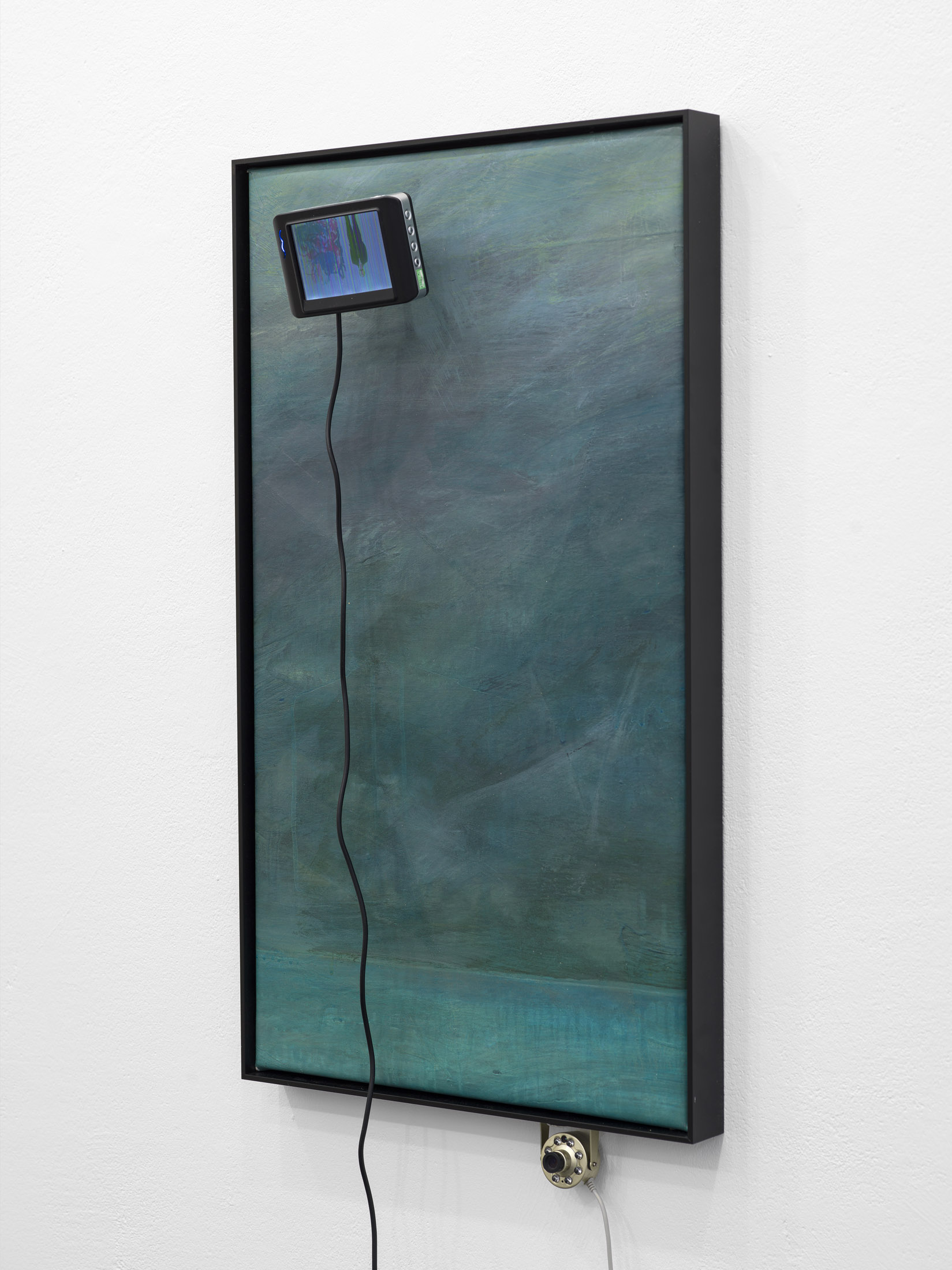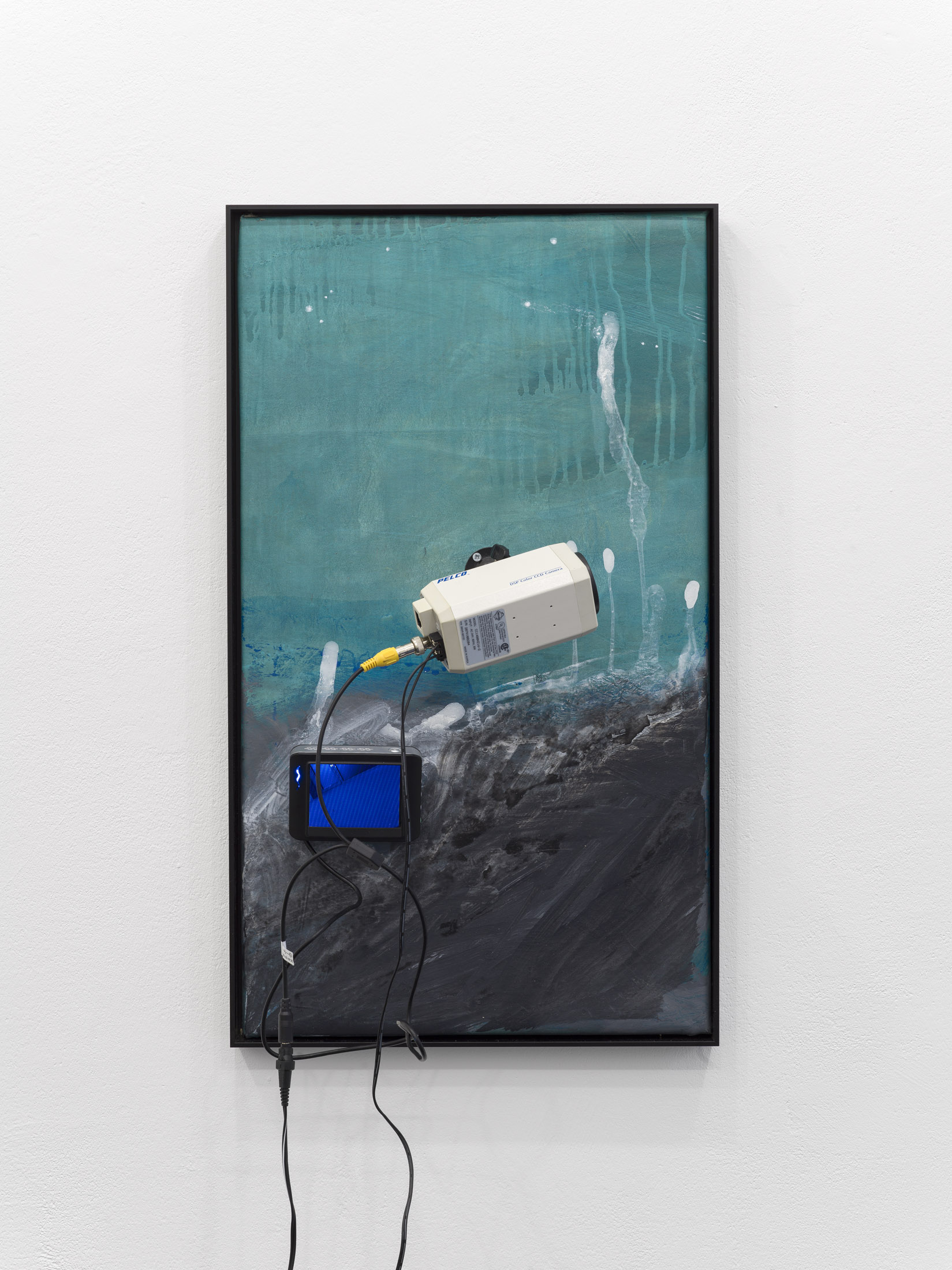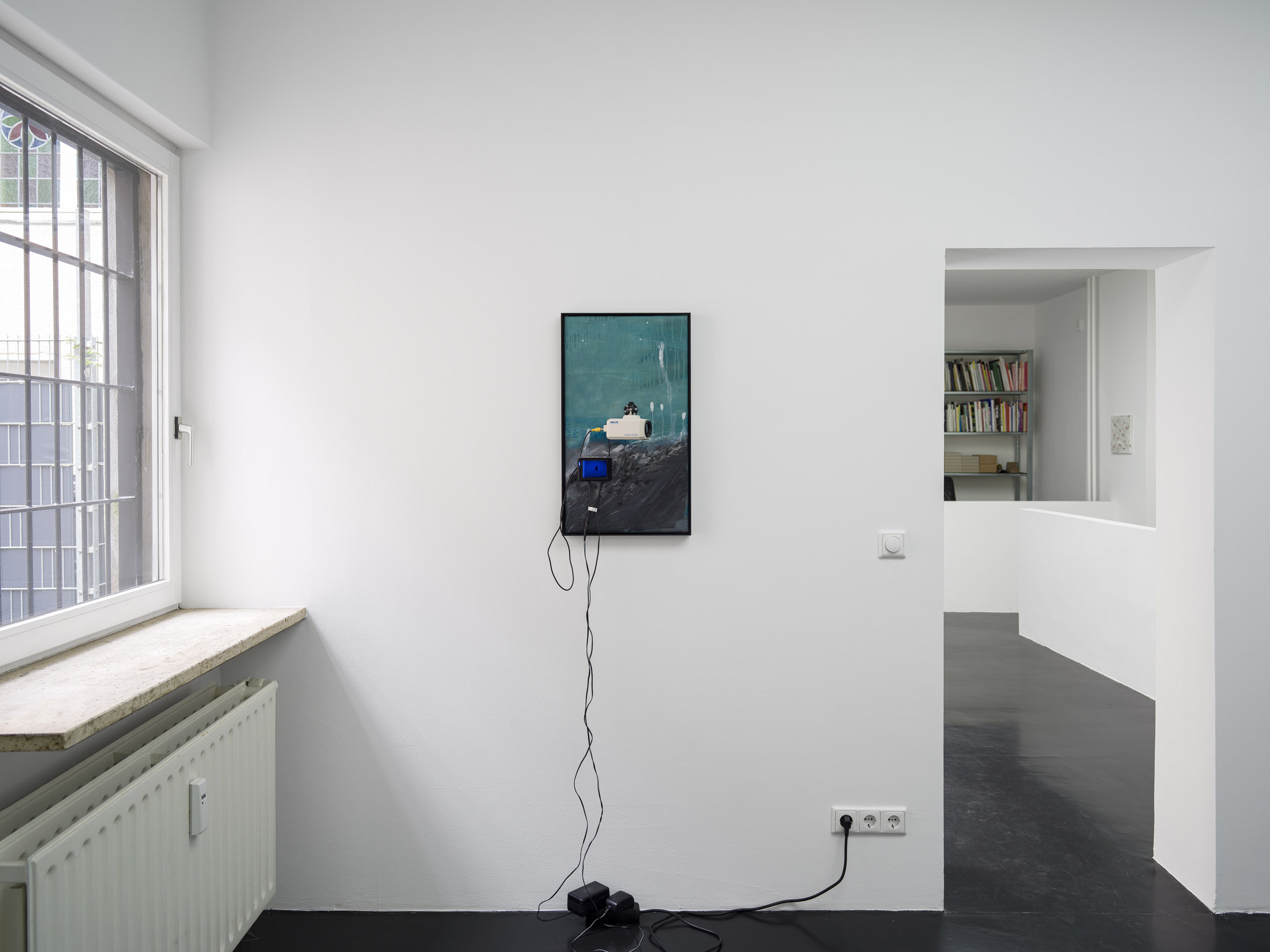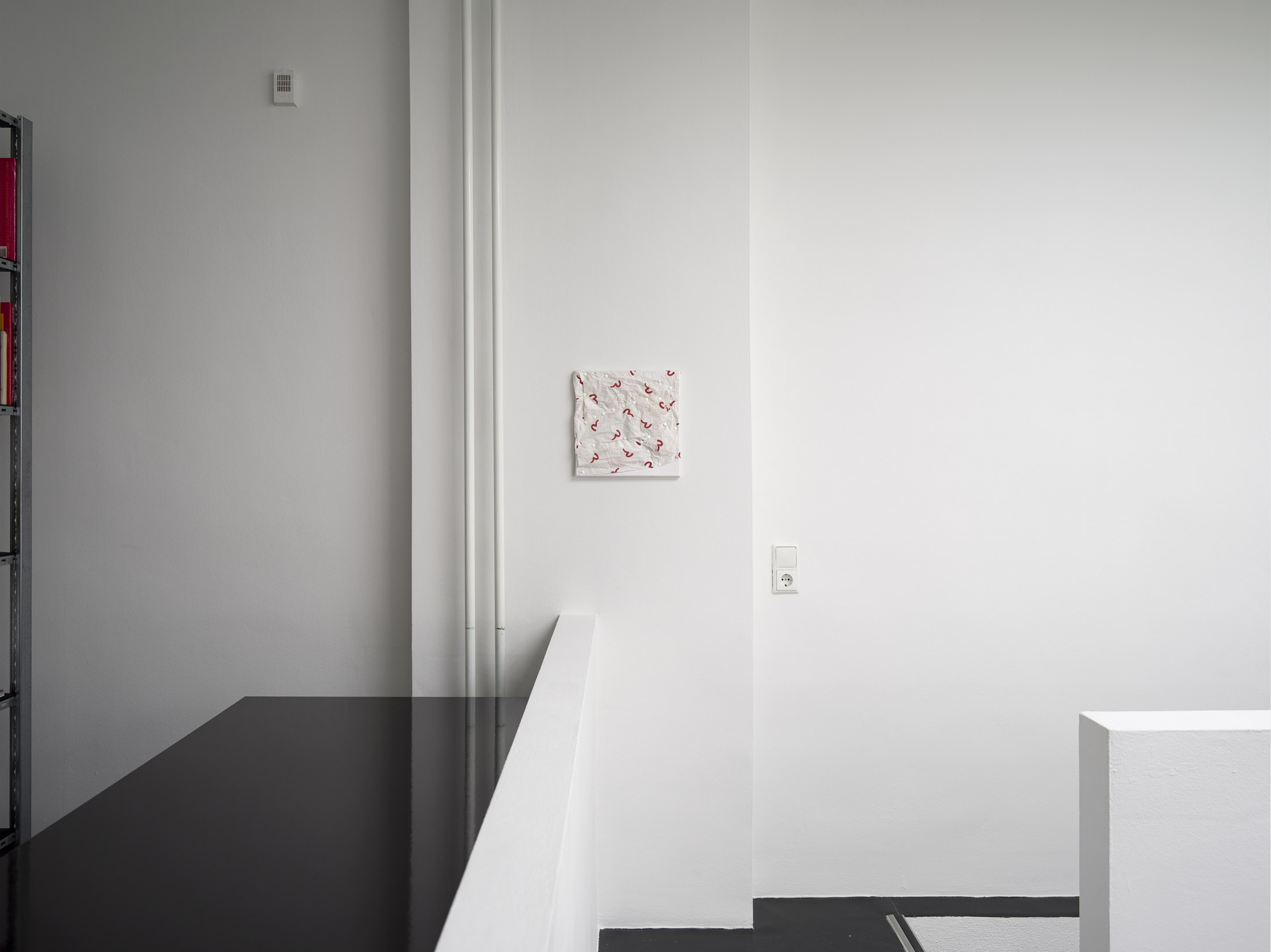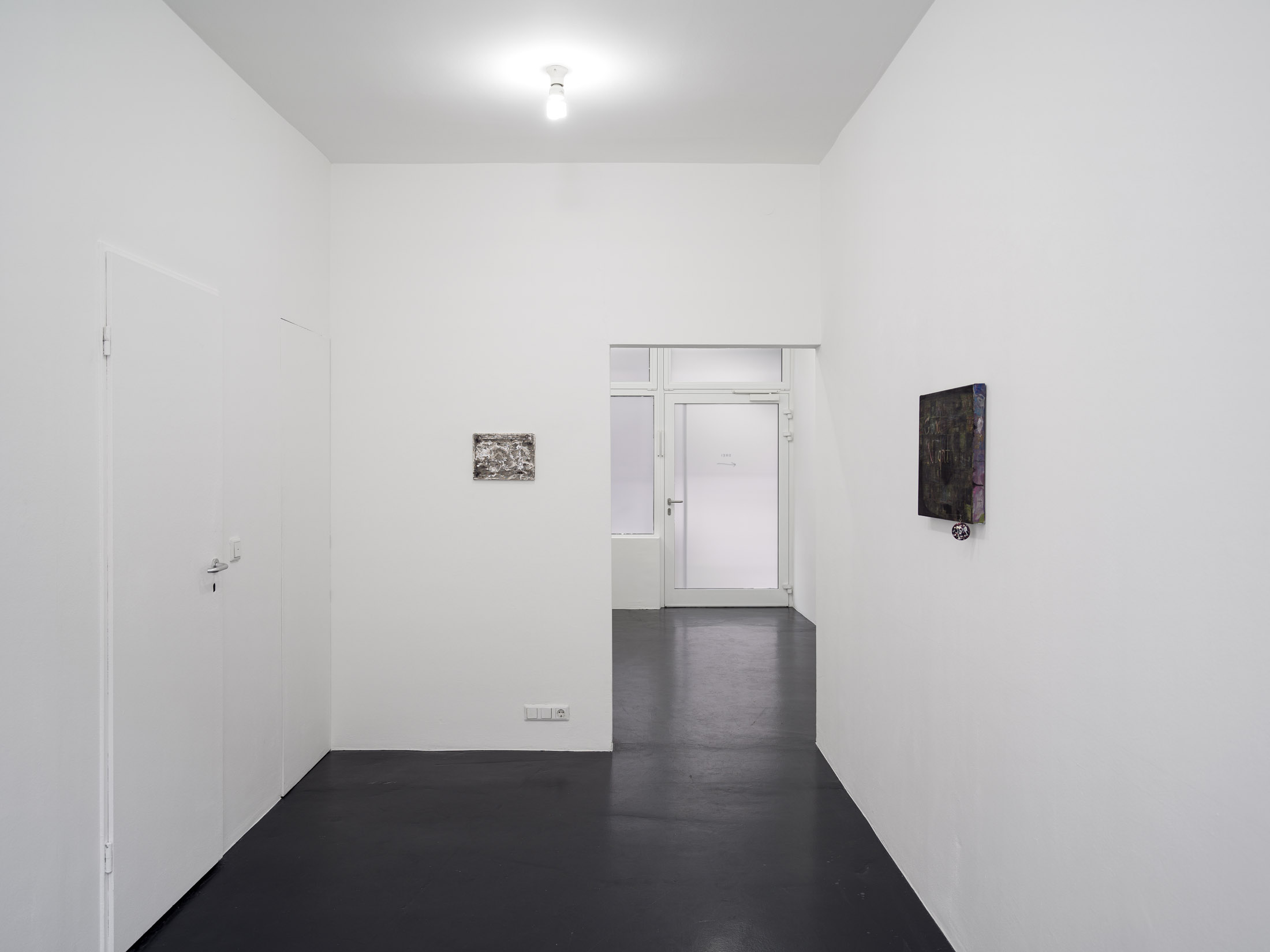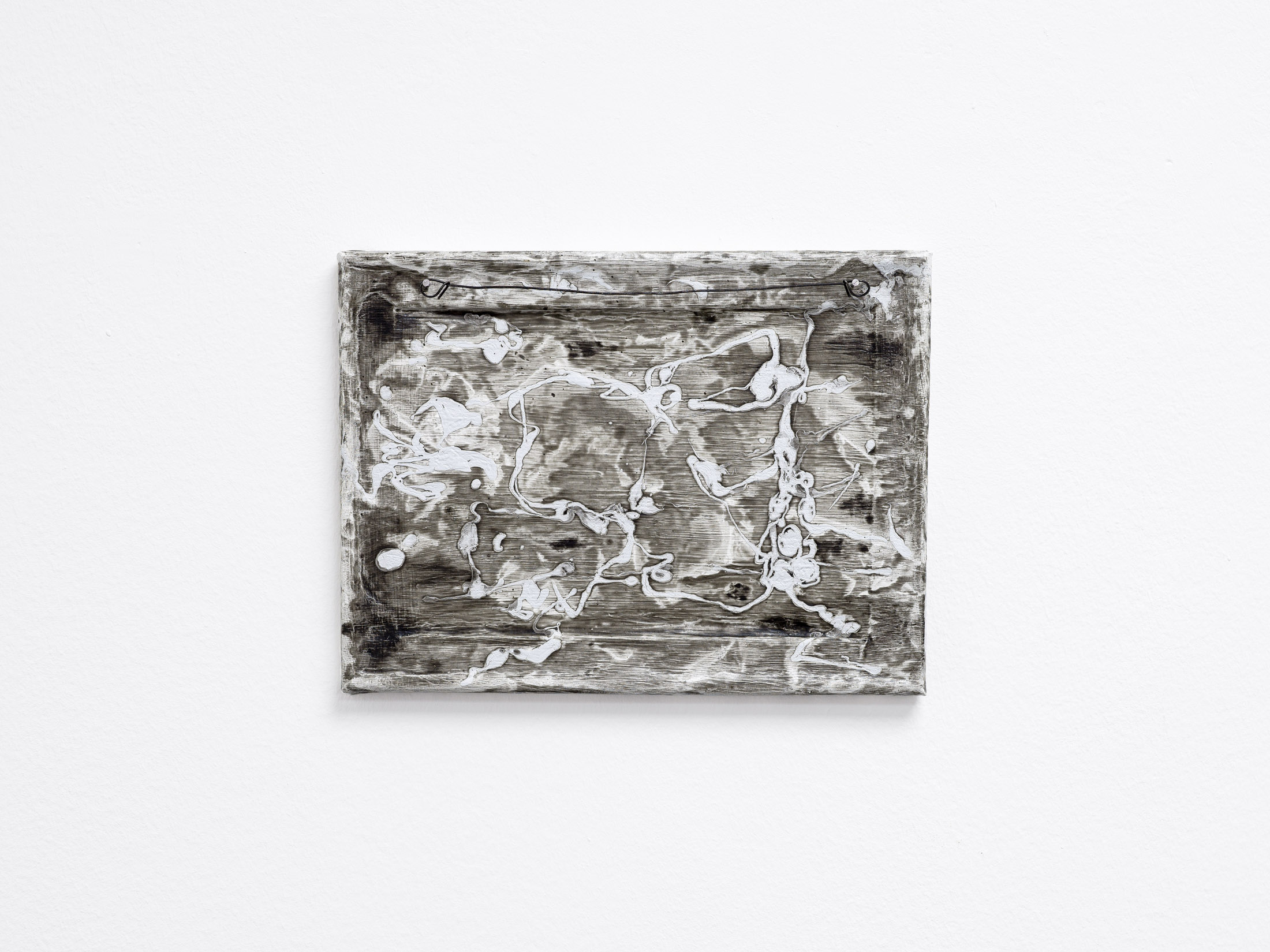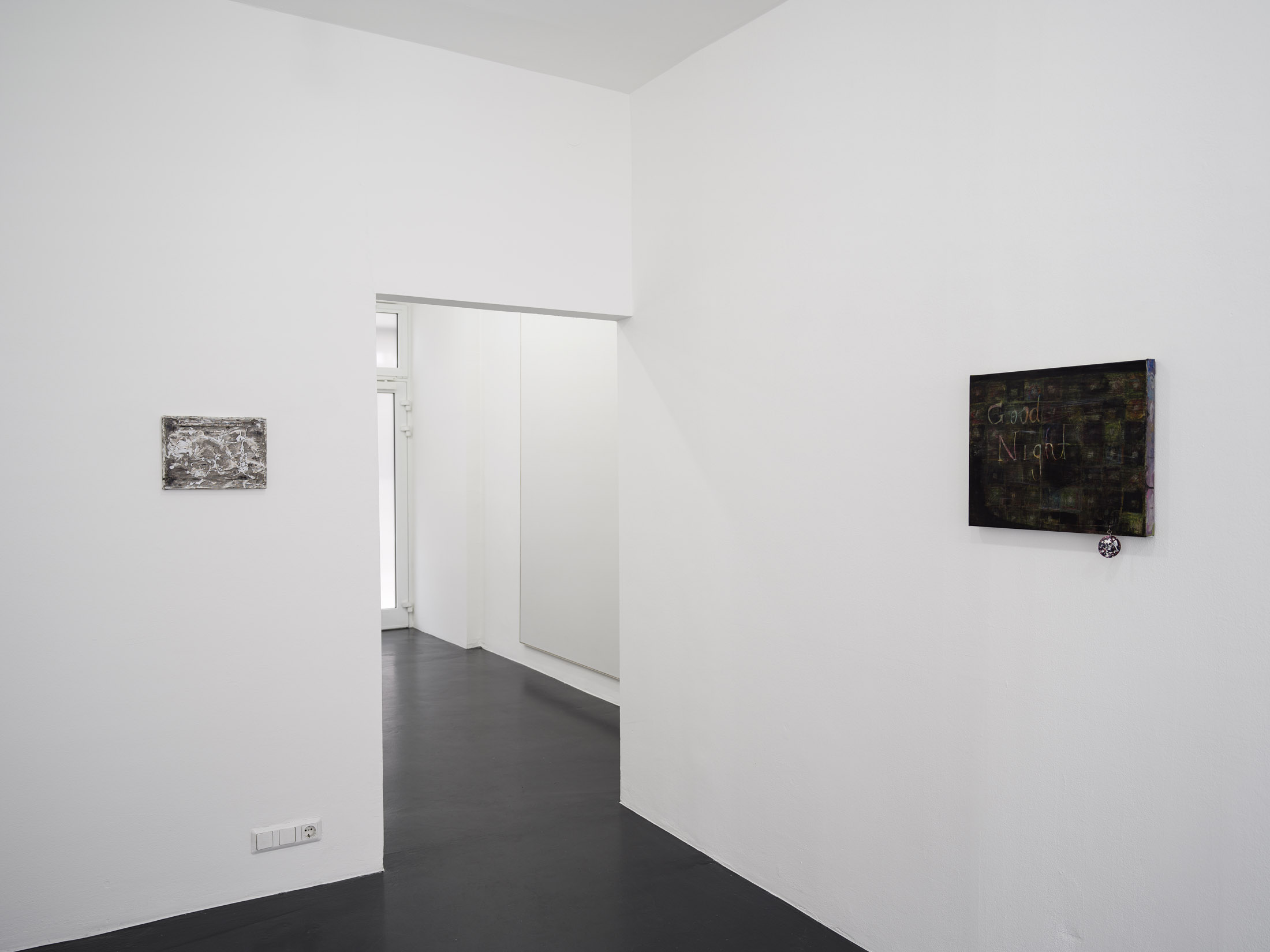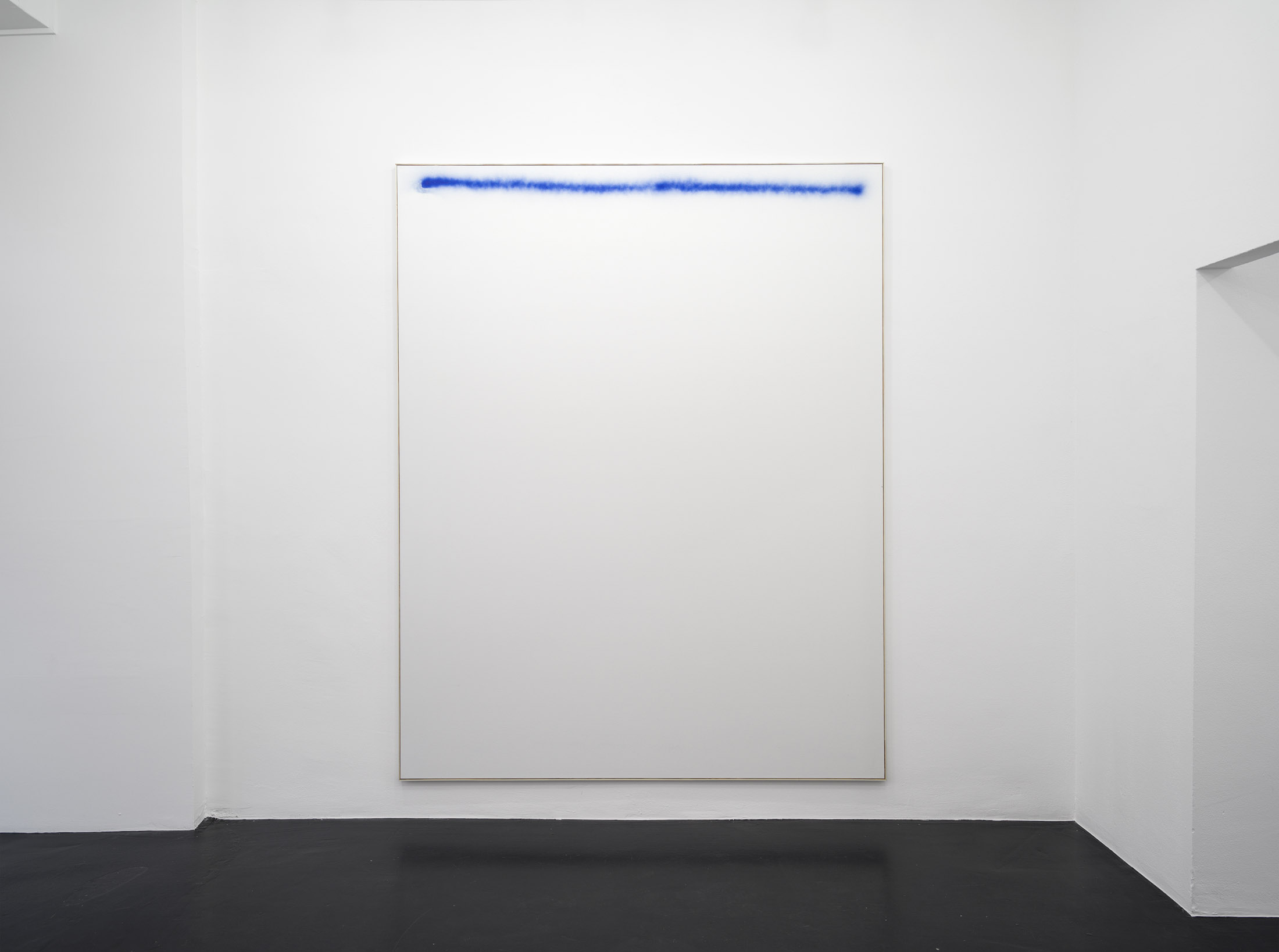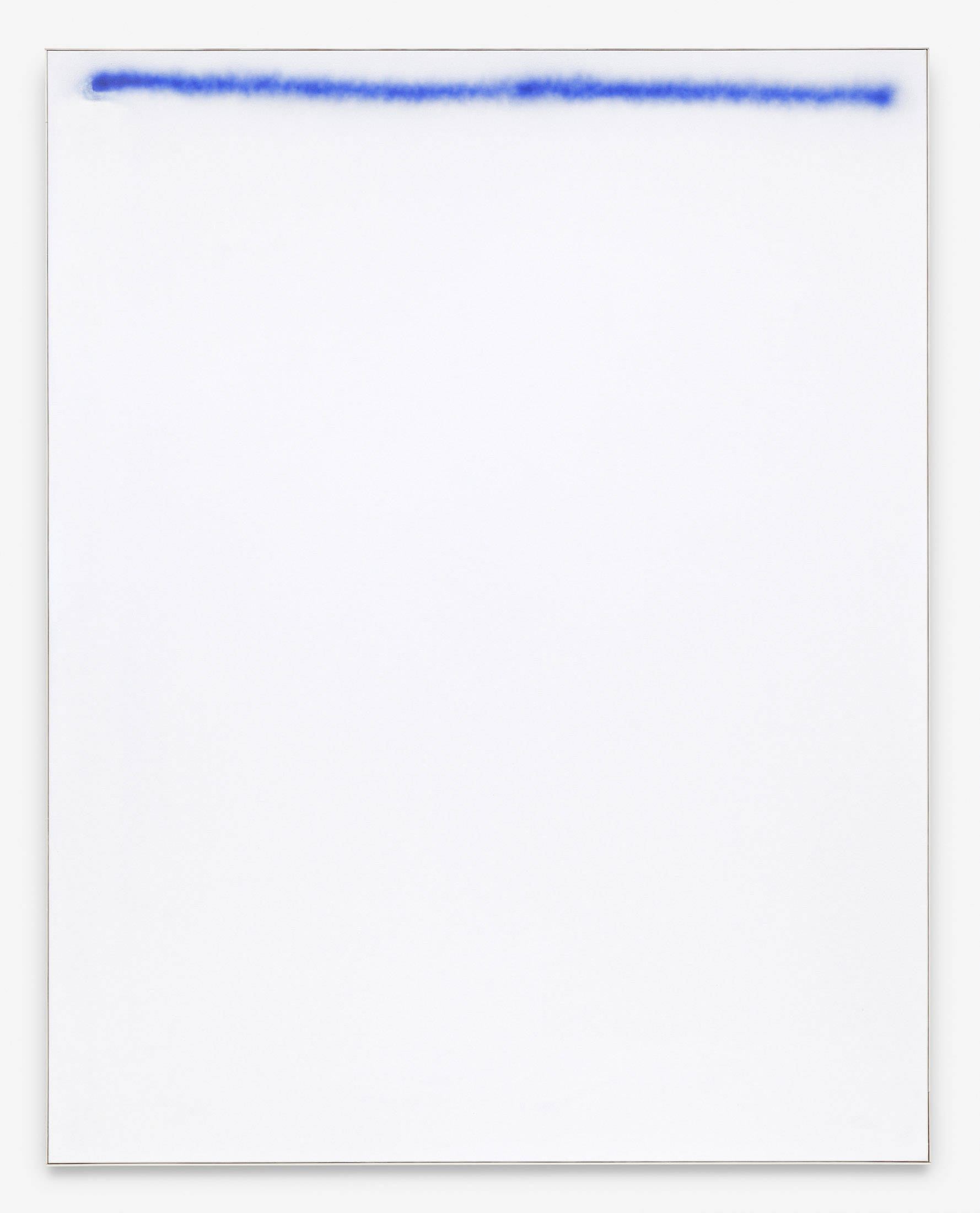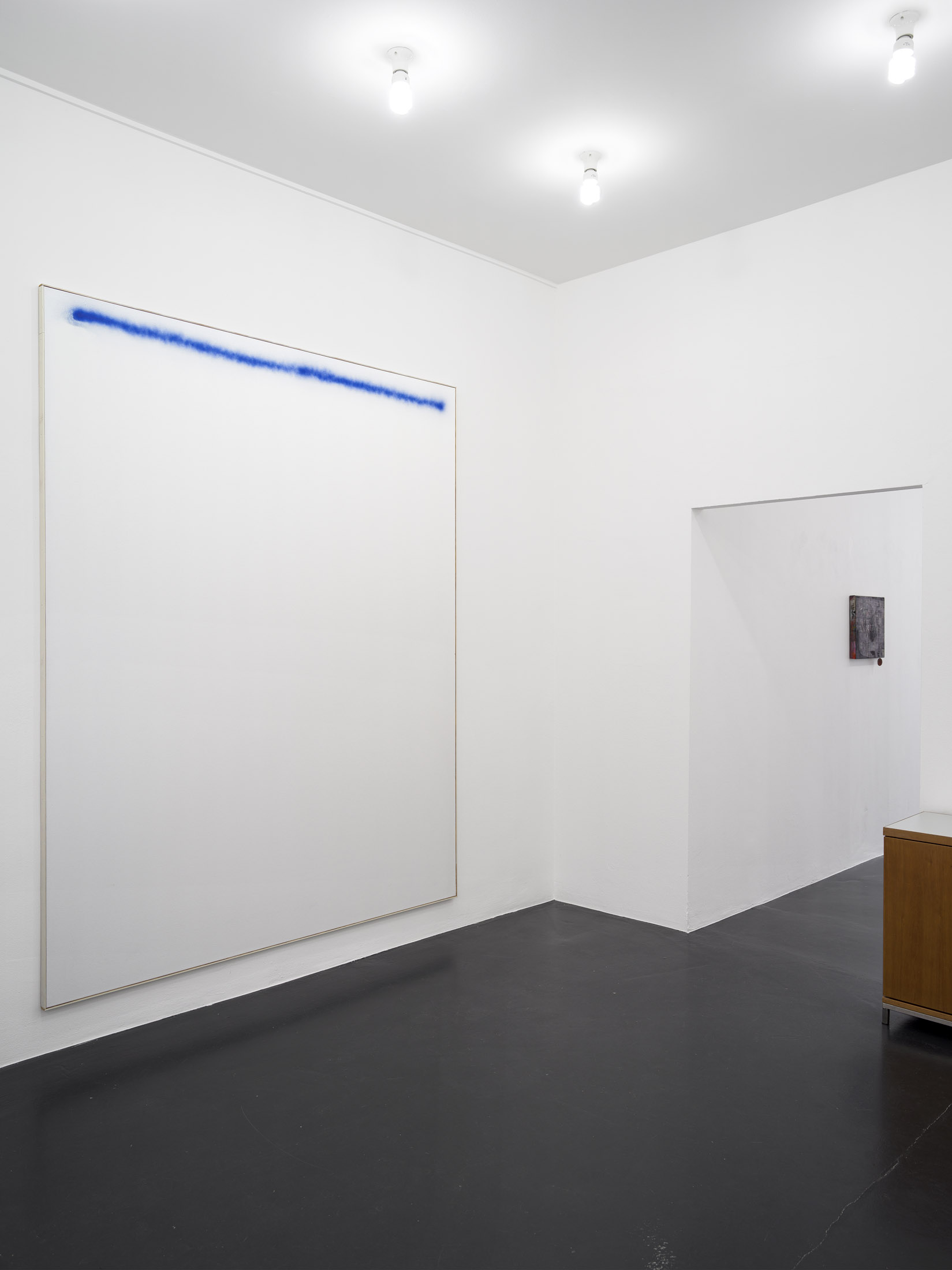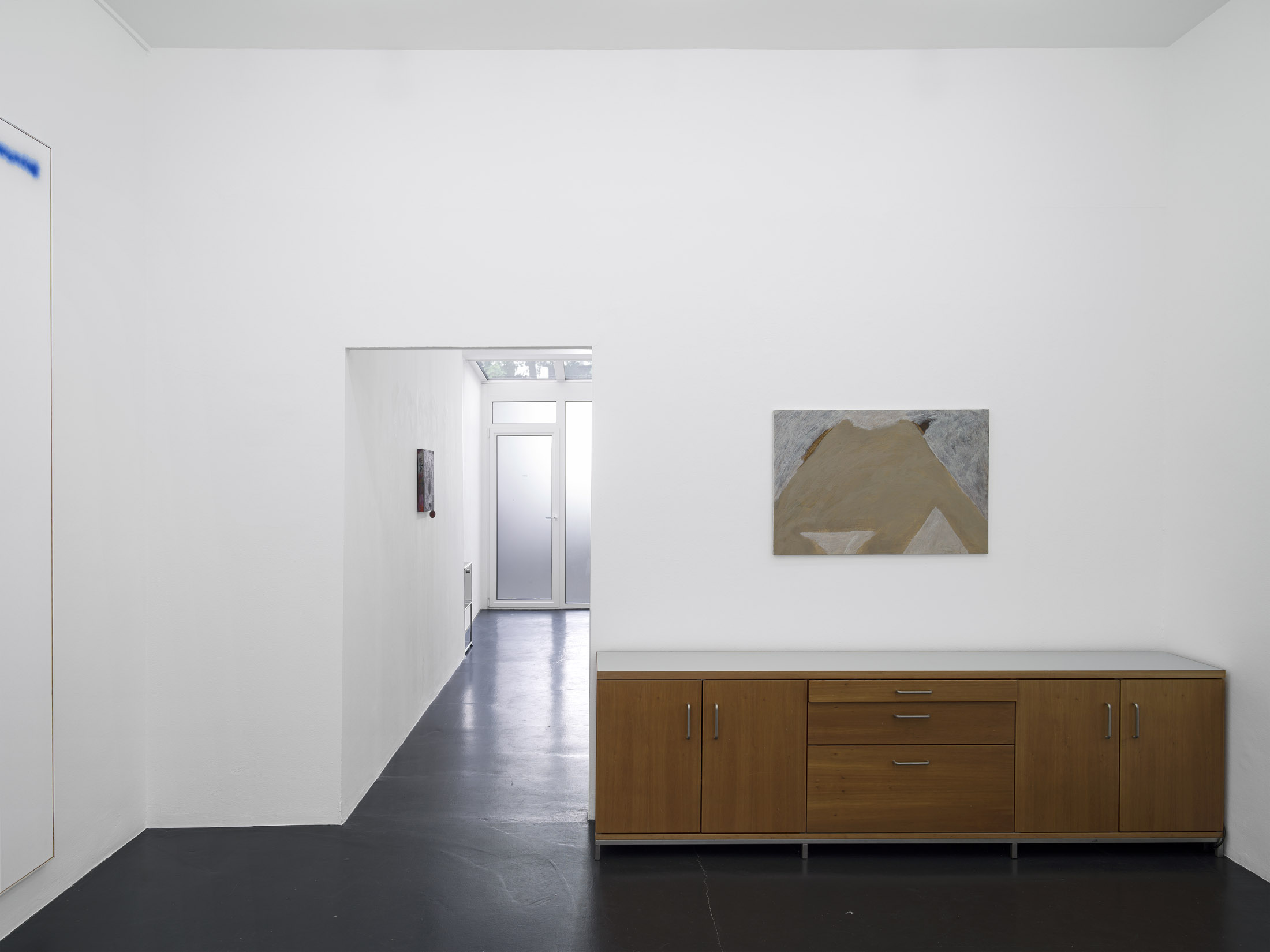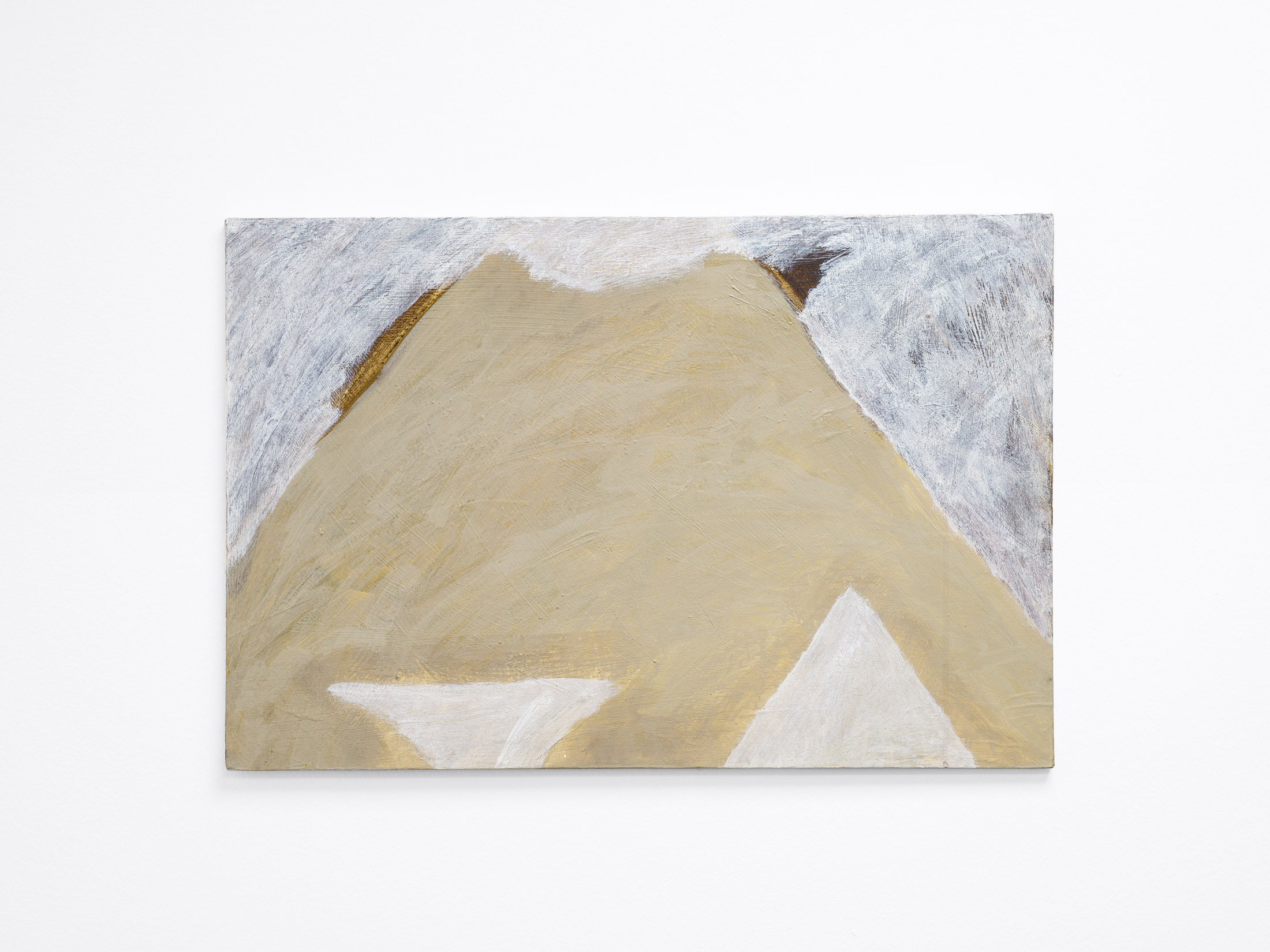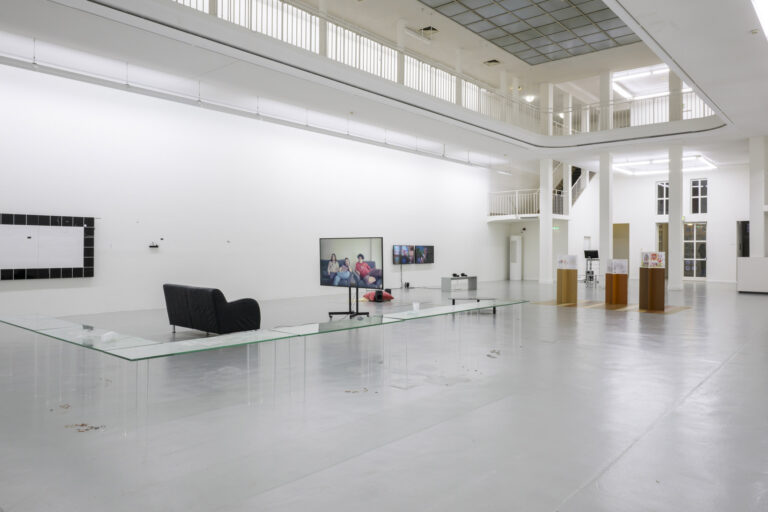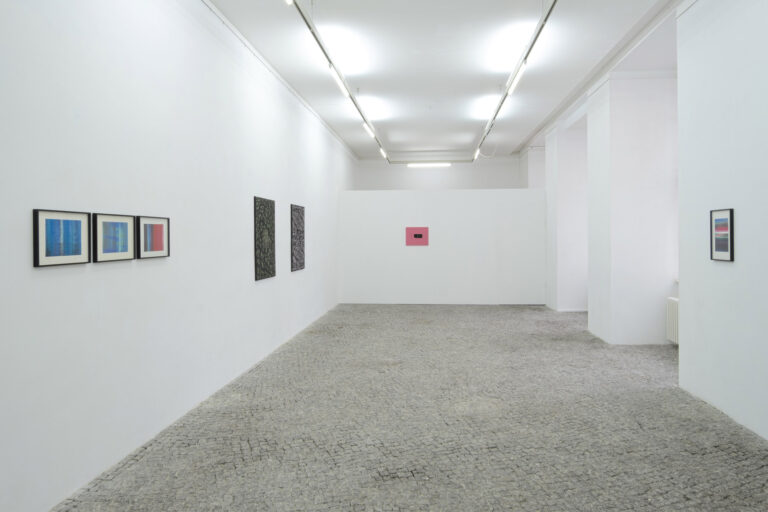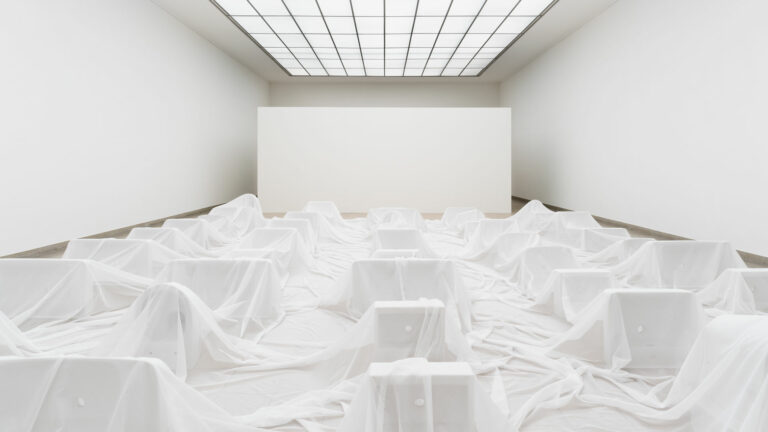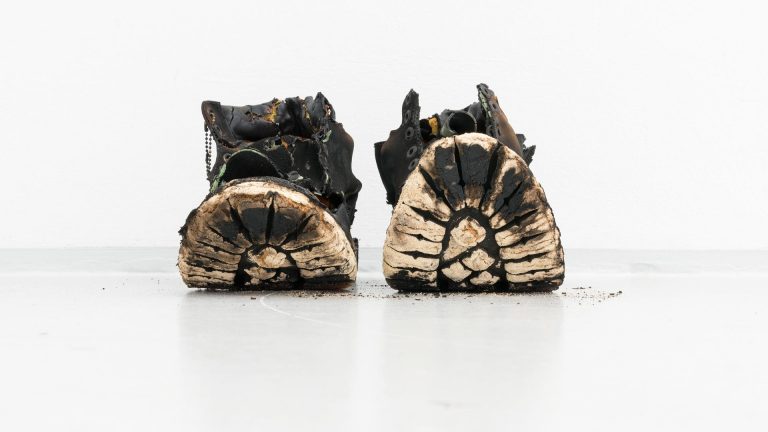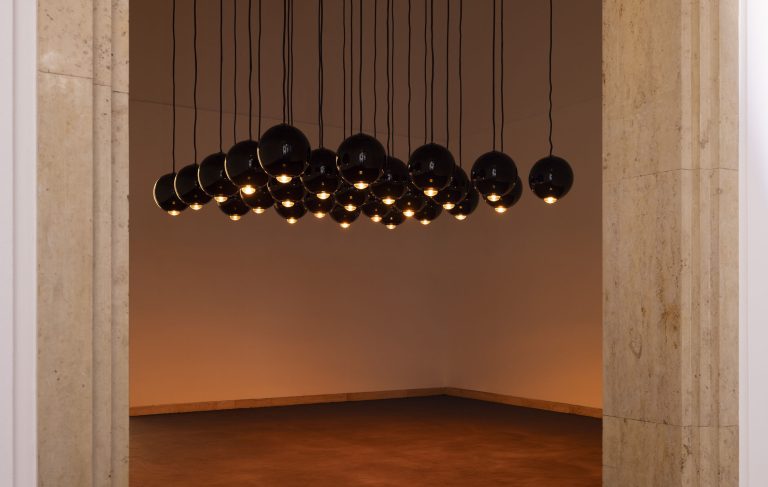Artists: Whitney Claflin, Matthias Groebel, David Ostrowski, Coumba Samba, Julia Scher, Josef Strau, Anna Virnich
Exhibition title: A Crooked World
Venue: DREI, Cologne, Germany
Date: June 30 – July 29, 2023
Photography: all images copyright and courtesy of the artists and DREI, Cologne
A Crooked World compiles works by Whitney Claflin, Matthias Groebel, David Ostrowski, Coumba Samba, Julia Scher, Josef Strau, and Anna Virnich, all of whom contributed and continue to contribute in different ways to the expansion of the landscape of abstract painting. While themselves remaining abstract, the works on view show their connection to landscape (an ever rich source for abstraction and summer exhibitions alike) along the keyboard of “approximations“, colors, mental topographies, formal concepts, scenes, and tech revolutions. In the close connection of the participating artists with the cities of New York and Cologne, the exhibition takes up one of the most important axes in recent art history. The title refers to a recent painting by Whitney Claflin, inspired by the Silver Jews album cover for American Water– a quintessential depiction of an American freeway. Claflin’s painting transformed this scene into a depiction of a sun/moon/orb with its reflection on the ground off center… “Because the world is crooked“ (Whitney Claflin, 2022).
For Whitney Claflin (b. 1983, Provedence, RI, United States) painting is always an open ended. Her works embody their own mood, so much so that the mood becomes a being itself. She gives body to conflict, amplifies subjectivity, and highlights the feedback-looping maximalisms of the moment. Non paint materials are collected from her everyday and contribute to a work which is useful to think of as “mostly painting” – a guide, a mix tape, asking you to consider one thing and then the next while you still have the last thing stuck in your head.
Monuments Blinking (2023) – one of two new paintings on view – is named after the Q and Not U song “End the Washington Monument (Blinks) Goodnight“, “because I thought of the grid as a cityscape and the various colors of the squares blinking on and off at the viewer. It also references an older, or, “vintage” color palette-the Klee originally, and then the late 90s coffee shop aesthetic of saturated earth tones. I saw Q and Not U play at AS220 in Providence, which is an iconic alternative cafe venue, and was trying to locate the painting in that environment… It looks like cafe art on purpose, if that makes sense.“ (Whitney Claflin)
In review, Matthias Groebel’s (b. 1958, Aachen, Germany) practice can be considered a radical counter-position to the “post-studio painting” that manifested itself in Cologne in the early 1990s and became part of the International canon. His paintings differ from conventional paintings in their machine-assisted production. New technology came to market in the 1980s, allowing analog television waves to be transferred into digital computer pixels; inspired by this, Groebel used found photocopiers and windshield-wiper motors to construct a complex machine, able to transfer TV images onto canvas via an airbrush gun and a multi-step, mechanized paint application process. Extracted and appropriated from the constant flow of the 1980s and 1990s television, these images possess an ambivalent, mysterious, and physical presence that emits a profound psychological latency.
“As with my previous works, television images serve as the source material for the images of the work group ’Hacked Channels’. These special television images are transmitted encoded via satellite, the associated decoders may not be legally operated in Germany. A number of programs are made available on hacker sites on the internet, which attempt to reconstruct the original television images from the transmitted signals. Far from their self-imposed goal of perfect decoding, the software delivers flickering, dancing, mostly monochrome structures in which the recognizable image fragments are repeatedly lost. These images are not abstract, for they do not abstract; on the contrary, they are stuck, as it were, on the reverse path before the actual figure is found. Transposed into painting, they develop a peculiar spatiality, which I hereby introduce into my work as an alternative to the representation of space hitherto gained exclusively through the representation of the body. At the same time they complement the “Anatomy of Forgetting“ by a chapter about the origin of hallucinations.“ (Matthias Groebel, August 1999)
David Ostrowski (b. 1981, Cologne) has produced a body of work that revolves around the idea of the zero point—a place of nothingness or the beyond of cultural and painterly codes. Ostrowski’s paintings are products of a desire to eliminate painterly knowledge. They are expressions of the idea that in producing notions of emptiness, one also grapples with and comments on the history of painting. The Cologne-based artist’s light-handed and complex approaches to the non-motif open the space of the canvas to unique breaches of perception and an unexpected freedom of seeing.
His minimal, gestural works abandon both the traditions of figuration and the conventions of abstraction. Their tension derives from an irreducible pictorial uncertainty. Ostrowski consistently refuses to comply with the usual criteria for creating value in contemporary art: material value, painterly bravura, conceptual references, institutional critique, ties to intellectual discourse, or forced self-referentiality. His works thwart not only any desire for interpretation, but often even the attempt to classify or catalogue them. Like many of his paintings, F (Sky’s the limit) (2014) is titled F – a letter that some commentators have interpreted to stand for “failure” or Fehlermalerei (“error painting”). This is the first time the painting is exhibited publicly.
Coumba Samba (b. 2000, New York City) is an interdisciplinary artist based in London, UK. Her work is rooted in studying process, hybridity, materiality and modes of visual communication. Samba investigates the uneasy relationships between the durable and the temporary against a backdrop of uncertainty and accelerated cultural consumption.
In Rubber Door (for Box) (2023) a sheet of stretched rubber is pasted and pinned onto a found wooden door. The rubber is painted in fluorescent yellow – a colour commonly used in industrial construction as a marker for gas and oil work. Samba interrogates oppression systems and recycling of narratives that exist within the capitalist enterprise, drawing on her brother’s experience of systemic incarceration to building work. Striping domestic and functional materials of their intent and definition to build them up again in a questioning of language and relations. Box is an ongoing assemblage piece with parts that will never meet; forever estranged, telling the same story.
A self-proclaimed “closet painter,” Julia Scher (b. 1954, Los Angeles) is most widely known for her work in performance and video installation. The three early works on display tether the beginnings of the artist’s interest in surveillance to her landscape painting practice of the 1980s. Upon receiving her first video camera, Scher began to conceptualize landscape through painting and video.
Security Landscape of the Year (1982/ 2012) is based on repurposed landscape paintings from 1982. In 2012, Scher sliced open some of her early, large-scale works to mount live feed cam- eras and monitors inside. The gesturally sketched landscapes have a dark, apocalyptic mood – something that also appears in the artist’s Toxic Landscapes (1980–82) photographs – that is intensified by the presence of live footage from a surveillance camera. The camera focuses on what is happening in front of the painting and transmits it to the monitor, allowing viewers to see themselves on the monitor as they stand in front of the work. This approach adds a medial quality to the relationship between the landscape painting and the viewer. The genesis of the work harkens back to the pre-selfie era, to the days of Super 8mm film, VHS, and cameras unconnected to smartphones.
Josef Strau’s (b. 1957, Vienna) tin and wire works on canvas are approximations of paintings, as the artist describes them. Made from thin sheets of metal plied into ridges and furrows and soldered into place, the works’ varied textures and visible fastenings assert their own topography. Strau heightens that link to landscape through a horizontal orientation: splayed out like a map, each painting evokes other kinds of lateral movement, like daily circuits through the city.
New Angel 6 (2021) is part of a series of “Angel“ and “New Angel“ paintings, produced with the preconceived intent of following a rather impossible, maybe even questionable attempt to depict the celestial beings as if they were a real object entirely defined by space. They were burnt and cut with a hot soldering stick out of natural tin and cover the fragmentarily painted and colored canvases. But as Giorgio Agamben described and more recently revived, angels are rather defined within modes of time and appear to repair what’s left from the past. The painting is accompanied by a text poster and a new photo retouch work.
Anna Virnich’s (b. 1984, Berlin) work draws on a wide range of materials and formal references. The textile tableaus however mark the center of her multi-media practice. Her approach to painting is unconventional in that it to the biggest extend involves the rejection of paint itself in favor of textiles reflecting a history of use, and renouncing its traditional support – the canvas – in favor of a work which wavers between the formal parameters of painting and sculpture. The surfaces must be understood as in a state of constant inter-penetration, pervaded like a ghost and part of a network of an exchange of substances, technology, bodies, images and the light of your eyes.
The two works on view are part of a small series of paintings based on used textiles from a cloth factory in Sri Lanka. They show traces of human use such as sweat stains and a grid of lines created by folding and exposure to the sun.
A Crooked World, 2023, exhibition view, DREI, Cologne
A Crooked World, 2023, exhibition view, DREI, Cologne
Josef Strau, Engel mit Korrekturen, 2023, Text on poster, 84 × 59,5 cm (33 1/8″ × 23 3/8″)
Josef Strau, Engel mit Retuschierungen, 2023, Digital image retouch on adhesive paper, 29,5 × 21 cm (11 5/8″ × 8 1/4″)
Josef Strau, New Angel 6, 2021, Tin, solder, enamel and marker on canvas, 40 × 50 cm (15 3/4″ × 19 5/8″)
Josef Strau, New Angel 6, 2021, Tin, solder, enamel and marker on canvas, 40 × 50 cm (15 3/4″ × 19 5/8″)
Anna Virnich, Untitled (#15), 2014, Silk, yarn on wooden stretch frame, 180 × 119 cm (70 7/8″ × 46 7/8″)
Anna Virnich, Untitled (#15), 2014, Silk, yarn on wooden stretch frame, 180 × 119 cm (70 7/8″ × 46 7/8″)
Anna Virnich, Untitled (#15), 2014, Silk, yarn on wooden stretch frame, 180 × 119 cm (70 7/8″ × 46 7/8″)
A Crooked World, 2023, exhibition view, DREI, Cologne
Anna Virnich, Fever, 2014, Sunburned cotton on wooden stretch frame, 130 × 120 cm (51 1/8″ × 47 1/4″)
Anna Virnich, Fever, 2014, Sunburned cotton on wooden stretch frame, 130 × 120 cm (51 1/8″ × 47 1/4″)
A Crooked World, 2023, exhibition view, DREI, Cologne
A Crooked World, 2023, exhibition view, DREI, Cologne
Coumba Samba, Rubber Door (for Box), 2023, Rubber, paint, thumbtacks on wood, 192 × 76 × 6 cm (75 5/8″ × 29 7/8″ × 2 3/8″)
Coumba Samba, Rubber Door (for Box), 2023, Rubber, paint, thumbtacks on wood, 192 × 76 × 6 cm (75 5/8″ × 29 7/8″ × 2 3/8″)
Matthias Groebel, Hacked Channels 07, 1999, Acrylic on canvas, 115 × 100 cm (45 1/4″ × 39 3/8″)
Matthias Groebel, Hacked Channels 07, 1999, Acrylic on canvas, 115 × 100 cm (45 1/4″ × 39 3/8″)
A Crooked World, 2023, exhibition view, DREI, Cologne
A Crooked World, 2023, exhibition view, DREI, Cologne
Julia Scher, Security Landscape of the Year, 1982/ 2012, Surveillance system, brackets, acrylic and plaster on tarpaulin, mdf, screws, transformers Painting panels excluding objects: 64 × 37 × 2,5 cm (25 1/4″ × 14 5/8″ × 1″)
Julia Scher, Security Landscape of the Year, 1982/ 2012, Surveillance system, brackets, acrylic and plaster on tarpaulin, mdf, screws, transformers Painting panels excluding objects: 64 × 37 × 2,5 cm (25 1/4″ × 14 5/8″ × 1″)
Julia Scher, Security Landscape of the Year, 1982/ 2012, Surveillance system, brackets, acrylic and plaster on tarpaulin, mdf, screws, transformers Painting panels excluding objects: 64 × 37 × 2,5 cm (25 1/4″ × 14 5/8″ × 1″)
Julia Scher, Security Landscape of the Year, 1982/ 2012, Surveillance system, brackets, acrylic and plaster on tarpaulin, mdf, screws, transformers Painting panels excluding objects: 64 × 37 × 2,5 cm (25 1/4″ × 14 5/8″ × 1″)
A Crooked World, 2023, exhibition view, DREI, Cologne
A Crooked World, 2023, exhibition view, DREI, Cologne
Coumba Samba, Evisu, 2023, Label paper, thumbtacks, paint on canvas, 30 × 30 cm (11 3/4″ × 11 3/4″)
A Crooked World, 2023, exhibition view, DREI, Cologne
A Crooked World, 2023, exhibition view, DREI, Cologne
Whitney Claflin, Monuments Blinking, 2023, Oil on canvas with enamel on found earring Canvas: 38 × 46 cm (15″ × 18 1/8″)
Whitney Claflin, Monuments Blinking, 2023, Oil on canvas with enamel on found earring Canvas: 38 × 46 cm (15″ × 18 1/8″)
A Crooked World, 2023, exhibition view, DREI, Cologne
Whitney Claflin, Did It, 2023, Oil, enamel, acrylic on poly rayon blend, nails, wire, 23 × 30 cm (9″ × 11 3/4″)
A Crooked World, 2023, exhibition view, DREI, Cologne
A Crooked World, 2023, exhibition view, DREI, Cologne
David Ostrowski, F (Sky’s the limit), 2014, Acrylic and lacquer on canvas; wood frame, 241 × 191 cm (94 7/8″ × 75 1/4″)
David Ostrowski, F (Sky’s the limit), 2014, Acrylic and lacquer on canvas; wood frame, 241 × 191 cm (94 7/8″ × 75 1/4″)
A Crooked World, 2023, exhibition view, DREI, Cologne
A Crooked World, 2023, exhibition view, DREI, Cologne
Julia Scher, Untitled, 1981, Mixed media on canvas, 61 × 91,5 cm (24″ × 36″)



